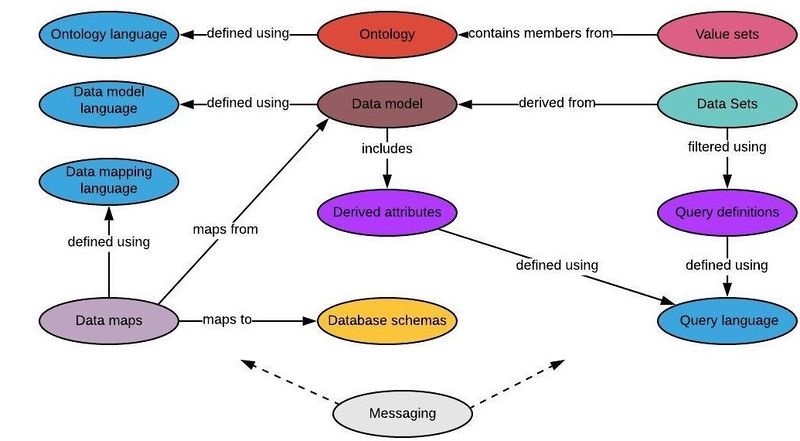The Discovery common information model consists of an integrated set of components that support machine processable and human readable information about data in the Discovery Data Service.
The model has a much broader definition than simply a data model. It involves the modelling of the meaning off data and the way in which data is converted to information.
More specifically, in this context, the information model is tailored to illustrate arrangements of health and care data as held in health records for the purposes of understanding and query as described by the objectives of the information model.
Objectives of the Common Information model
The common information model is a set of components designed to contribute to achieving the following objectives:
- Enable people who are not technical experts to visualise and understand the structure and content of health records.
- Enable people who are technical experts to design systems based on the logical structure and content of the model
- Enable people to define the data they need in order to perform advanced analytics or decision support, in particular where the definition involves subsumption testing
- Enable query authors to have a library of value sets and query definitions for re-use across the health sector
The model is technology and system independent, thus can be implemented in a technology of choice.
The model language is standards based, thus the model content can be exchanged using standards based messages. However, Discovery also uses a simpler JSON based syntax that is easier to comprehend and parse using object oriented programming languages. In addition the outputs of the model can be relational so they can easily be used by RDB based implementations.
At the core of the model is an ontology. The greater part of the ontology is based on the world leading health ontology Snomed-CT, which is itself now defined using the same ontology language OWL2.
Information model component types
The model involves an integration between different types of components linked together by a common modelling language which is both human readable (albeit quite technical) and machine readable. The components work together, so that the generation of output or the query of content, usually uses several components.
This diagram illustrates the main types of components of the model:
- The ontology language is the machine and human readable set of instructions as to what things mean and how they are classified. See the language as instructions to populate a model.
- The ontology is the set of concepts used in all parts of the information model, from clinical concepts through to data structure concepts
- A data model language is a simple set of classes used to define a logical data model.
- The data model is a set of entities, attributes and value sets, all of which are defined precisely in the ontology, but he data model, being created for a specific business of healthcare is separate to the ontology.
- Value sets are business purposes specific collections of concepts from the ontology used in the data model or in query and contain concepts as defined in the ontology, using the ontology language, including advanced concept classes.
- Data set definitions apply rules and filters to a data model in order to specify the nature of the entries and their content required in a purpose specific data set
- Data model maps specify how data is transformed from a data model to a particular database.
- Data base schemas are reference schemas (RDB and maps) showing an implementation of a data model and data sets. Strictly speaking these are not part of the information model but are included as “proof of solution” of the model.
- Derived attributes are data model attributes defined using the query language.
- Query definitions are a library of re-usable queries.
Discovery ontology
The Discovery ontology defines the meaning of the concepts that make up the content of health records. The meaning is defined in a way that a computer can use to reason and analyse.
In reality the ontology is a semantic web of ontologies but in most cases the external ontologies are more accurately referred to as classifications or code schemes.
The exception to the rule is the world leading Snomed-CT ontology which is now based on a type of language known as Description logic and made available via three grammars, OWL2 and Snomed compositional grammar and Expression constraint language
The ontology is made of of a number of concepts (classes or properties) which are the subjects of axioms, which relate concepts to other concepts in a fractal like manner. The relationship can be illustrated as follows:
The ontology is precisely defined using the Discovery ontology language, which is itself a syntactical variation on the standard OWL2 language.

